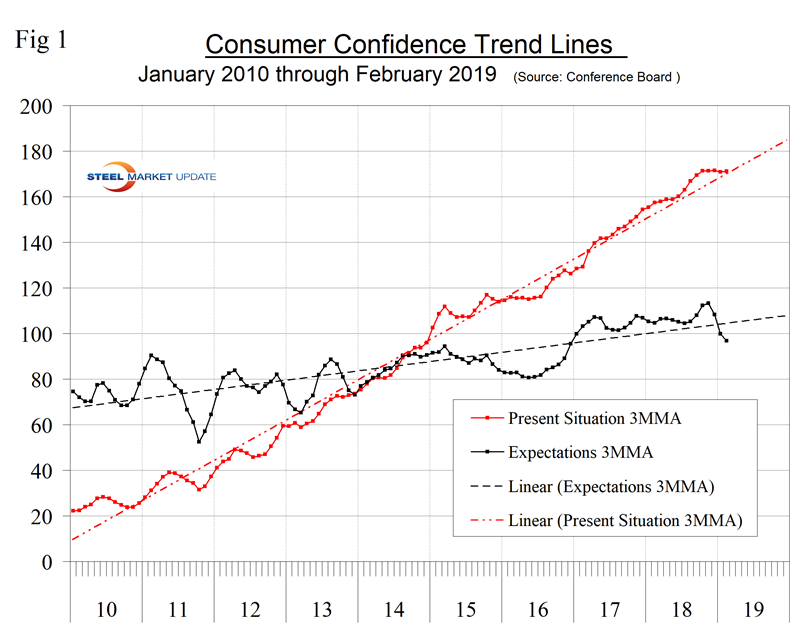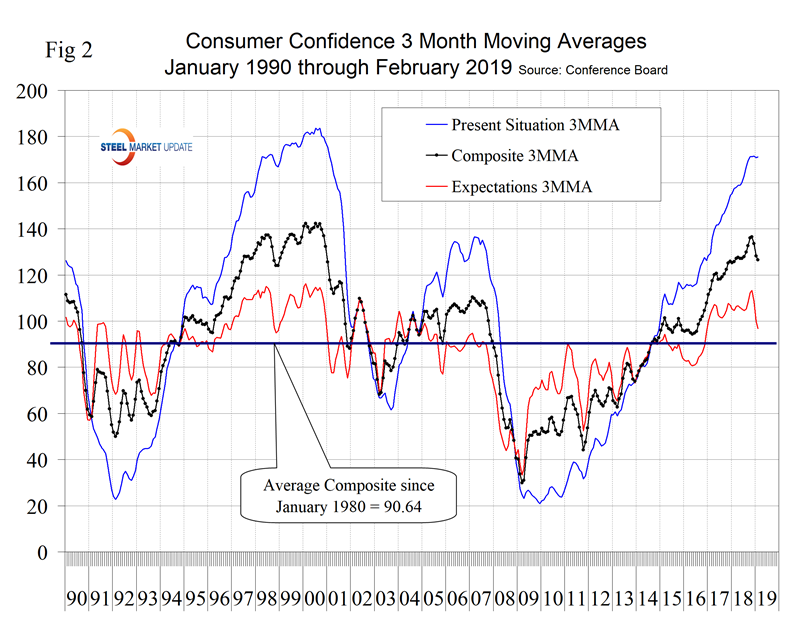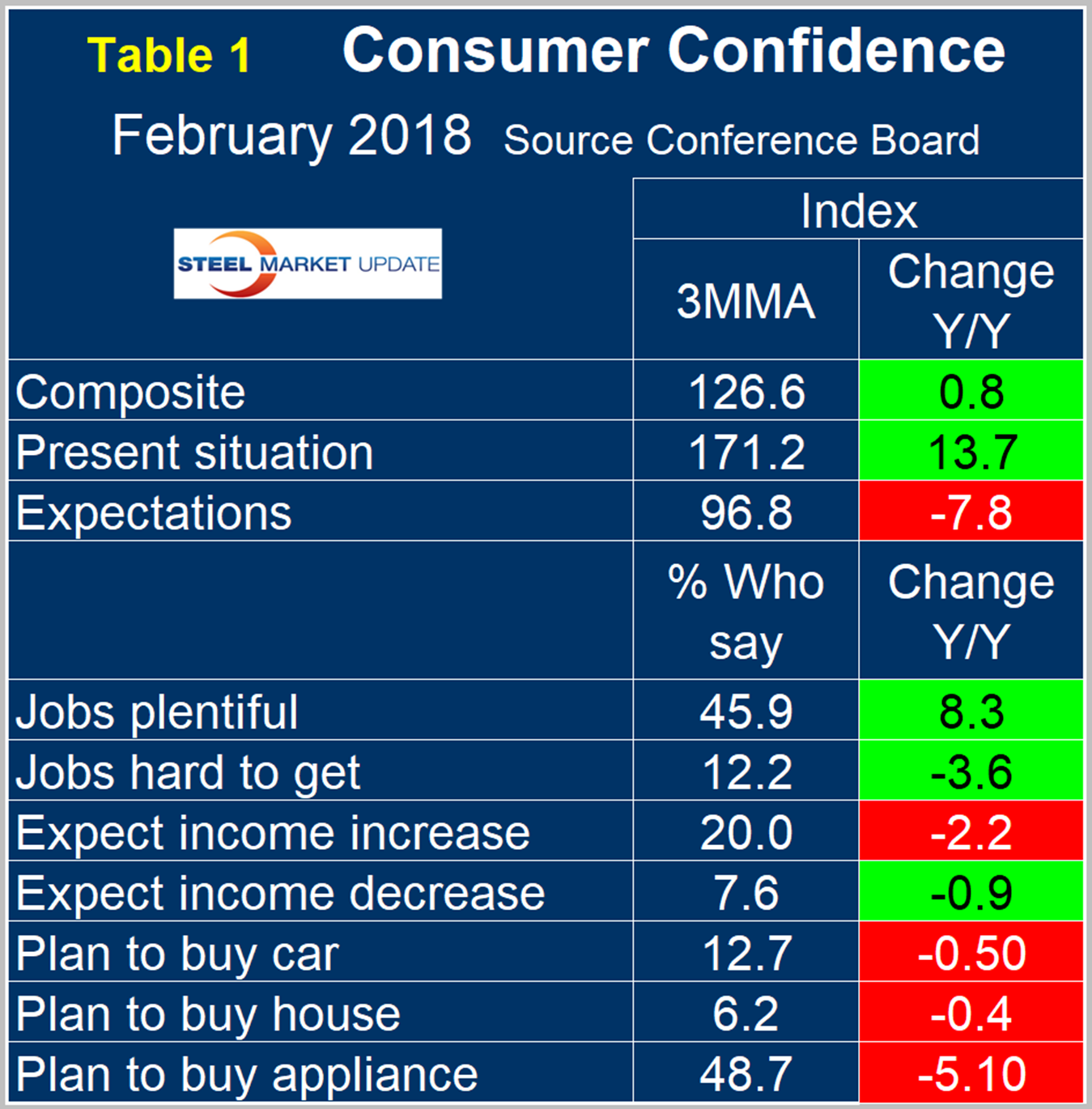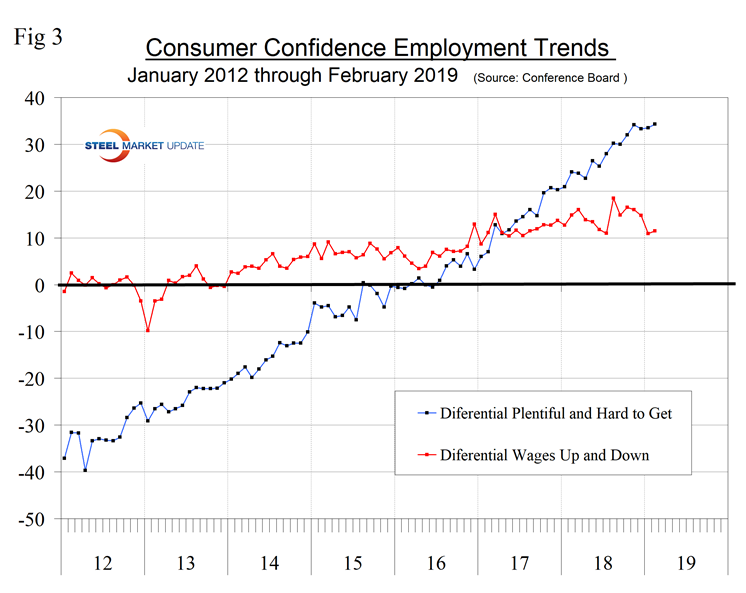Economy

Consumer Confidence Rebounds Following Government Shutdown
Written by Peter Wright
March 1, 2019
Consumer confidence rebounded in February as the negative effect of the government shutdown receded.
The Conference Board measure of consumer confidence declined each month November through January and surged in February. It appears that the shutdown had a major effect on consumers’ expectations, but not so much on their perception of the present situation.
The composite value of consumer confidence in February was 131.4, up from 121.7 in January. The 3MMA decreased from 128.2 in January to 126.6 in February, which was almost the same as February last year. We prefer to smooth the data with a moving average to reduce monthly volatility. The composite index is made up of two sub-indexes. These are the consumer’s view of the present situation and his or her expectations for the future. The present component is exactly on its nine-year trend line, but expectations have fallen below trend (Figure 1).

The Conference Board summary statement read: “Consumer Confidence rebounded in February, following three months of consecutive declines,” said Lynn Franco, Senior Director of Economic Indicators at The Conference Board. “The Present Situation Index improved, as consumers continue to view both business and labor market conditions favorably. Expectations, which had been negatively impacted in recent months by financial market volatility and the government shutdown, recovered in February. Looking ahead, consumers expect the economy to continue expanding. However, according to The Conference Board’s economic forecasts, the pace of expansion is expected to moderate in 2019.”
The improvement in the monthly composite was mostly due to rising expectations, which had plummeted in December and January. In January, the consumer’s view of the present situation improved from 170.2 to 173.5 and expectations improved from 89.4 to 103.4. The historical pattern of the 3MMA of the composite, the view of the present situation and expectations since February 1990 are shown in Figure 2.

On a three-month moving average basis, the expectations component is now lower than it was a year ago. The consumer’s view of the present situation has surged since December 2010, but has slowed in the last five months. Comparing February 2019 with February 2018, the 3MMA of the present situation was up by 13.7 and expectations were down by 7.8 points (Table 1).

The consumer confidence report includes encouraging data on job availability as 45.9 percent of respondents reported jobs to be plentiful and 12.2 percent reported jobs hard to get. Expectations for wage increases were not so positive; the percentage expecting a raise declined from February last year (Figure 3).

Consumer spending measures in February indicated that year-over-year plans to buy a car, a house and an appliance all declined for the first time since last July (Figure 4). Plans to buy an appliance were the lowest in over three years.

SMU Comment: The decline in consumer purchase plans was undoubtedly influenced by the political situation and government shutdown. It will require a couple more months of data before it is a cause for concern. Steel demand is dependent on the growth of GDP, which in turn is strongly influenced by consumer confidence and disposable income.
About The Conference Board: The Conference Board is a global, independent business membership and research association working in the public interest. The monthly Consumer Confidence Survey®, based on a probability-design random sample, is conducted for The Conference Board by Nielsen. The index is based on 1985 = 100. The composite value of consumer confidence combines the view of the present situation and of expectations for the next six months.

Peter Wright
Read more from Peter WrightLatest in Economy

ISM: Manufacturing expansion loses steam after two months of growth
US manufacturing activity slowed in March after two straight months of expansion, according to supply executives contributing to the Institute for Supply Management (ISM)’s latest report.

Chicago Business Barometer rose to 16-month high in March
The Chicago Business Barometer increased for the third-consecutive month in March. Despite this, it still reflects contracting business conditions, as it has since December 2023.

Durable goods orders rise again in February
Transportation equipment led the increase, rising 1.5% to $98.3 billion.

Consumer confidence falls for fourth consecutive month
People remain concerned about inflation, trade policies, and tariffs.

Housing starts ticked up in February
Single-family starts last month hit a rate of 1.10 million, a month-over-month increase of 11.4%, census data shows.
